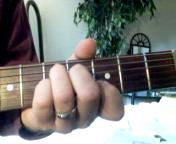Scroll through the lesson and click on notation/video/audio links to load the interactive players.
Please subscribe to get full access to all lessons for only $7.95/month PLUS 1 week free trial.

Riff Interactive lessons are
LESS expensive and
MORE interactive than alternatives!
More Info
|
|
| Lesson Subject:
Eric Clapton Style |
| What you learn:
Part 3 - BluesBreakers Era |
| Teacher:
Storm Stenvold |
Storm: In this lesson you'll learn a few
backing riffs and a 12 Bar solo in the style of Eric Clapton from his early days
with John Mayall and the Bluesbreakers. Go ahead and load up the jam track. It's
a 12 Bar Shuffle in the key of G.
Bluesbreakers 12-Bar
Storm: The three chords outlined are G7, C7 and
D7. Now Eric didn't do much chord playing in this project. He was pretty much
the 'lead' player. Still, good to know some basic
voicings.
Storm:
If Eric would play chords, he might often use 'partials'. Just two or three
strings to imply the changes. Here are the full voicings. Use the same
fingerings but experiment with these 'small' chords to the backing
track.
G7

C9

D7

Storm: More often Eric would play a riff to
outline the chord progression. When he wasn't playing fills and/or lead.
Storm: This riff
outlines the G7 chord change. It also could be thought of as coming from the G
minor pentatonic. C9 is an extension of C7. Both
fit. This riff could then be moved to outline
the progression.
Storm:
From the G at the 3rd fret, move up 5 frets for the C change, another 2 frets
for the D change. Or move the root note of the riff on to
the 5th string, staying at the 3rd fret. Then again up 2 frets for
D.
chaz: Can
I move from C9 to D9 also ?
Storm: Yes, all chords in blues
are commonly the same quality. So the C9 shape could be used up 2 frets to work
for D9. Up 7 frets works as G9 too.
More backing riffs. The last example adds a hammer-on triplet and alternates to
a different ending note. The 'blues' third. That 1/4 step
bend.
Storm:
This riff uses the same hammer-on move, this time out of the major pentatonic.
Storm:
This last riff is similar to the bridge of 'All Your Love'. Cover of the Otis
Rush song that kicks of the Bluesbreakers album. The last riffs also incorporates a
position shift. Necessary to reach the high note of the last example.
Storm: Lets check out a solo in
Clapton's style from this album. Then we'll break it down into separate licks
that work with the jam track at the beginning. Listen to this next sound clip:
12 Bar
Chorus - Bluesbreakers style
Storm: Through the form,
12 bars for this progression, is called a 'chorus' in jazz and
blues. The opening lick starts on the 2nd beat.
Half-step bends into the b7 of the scale. The blues 3rd again. And a hammer-on
grace note adds some color to a familiar I-IV-I chord
riff.
Storm: Here is a video clip to the
phrase.
lick1
Storm:
This next phrase goes over the G7 to C7 change, bars 4-5.
sj: Clapton
doesn't use his pinky much
Storm: Not much at all in soloing. He'll use it
in his chord playing. The double-stop riff in the lick works
well over any chord of the progression. The end of the phrase is the start of
the C chord change. Uses the minor pentatonic scale.
chaz:
Is this all down picking in lick 2?
Storm: In a position often called the 'Albert
King' box. I used all down strokes on that phrase,
yes. Here is video clip. Just the left hand:
lick2
Storm:
The next example really has two separate licks in it. The first half uses a half step bend at
the 10th fret. Kind of a mix of the minor pentatonic with the 2nd
added. Then a combination bend as the
progression changes back to the I chord, G. First a whole step bend, then 1 1/2
steps, then a 1/2 step. Eric uses this technique as a big part of his
phrasing.
lick3
Storm:
This riff is over the V chord, D. Bend of the root note up a whole step
over this chord change. More minor pentatonic otherwise, with position shifts by
sliding.
Lick4
Storm:
And a turnaround lick to take us to the
top.
Turnaround Lick
Storm: On to the next lesson when you're ready!
|
<< load notation from left
|
|
<< load audio from left
|
<< load audio from left
|